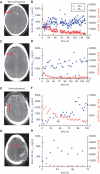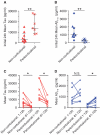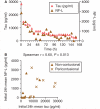Tau elevations in the brain extracellular space correlate with reduced amyloid-β levels and predict adverse clinical outcomes after severe traumatic brain injury
- PMID: 22116192
- PMCID: PMC3326246
- DOI: 10.1093/brain/awr286
Tau elevations in the brain extracellular space correlate with reduced amyloid-β levels and predict adverse clinical outcomes after severe traumatic brain injury
Abstract
Axonal injury is believed to be a major determinant of adverse outcomes following traumatic brain injury. However, it has been difficult to assess acutely the severity of axonal injury in human traumatic brain injury patients. We hypothesized that microdialysis-based measurements of the brain extracellular fluid levels of tau and neurofilament light chain, two low molecular weight axonal proteins, could be helpful in this regard. To test this hypothesis, 100 kDa cut-off microdialysis catheters were placed in 16 patients with severe traumatic brain injury at two neurological/neurosurgical intensive care units. Tau levels in the microdialysis samples were highest early and fell over time in all patients. Initial tau levels were >3-fold higher in patients with microdialysis catheters placed in pericontusional regions than in patients in whom catheters were placed in normal-appearing right frontal lobe tissue (P = 0.005). Tau levels and neurofilament light-chain levels were positively correlated (r = 0.6, P = 0.013). Neurofilament light-chain levels were also higher in patients with pericontusional catheters (P = 0.04). Interestingly, initial tau levels were inversely correlated with initial amyloid-β levels measured in the same samples (r = -0.87, P = 0.000023). This could be due to reduced synaptic activity in areas with substantial axonal injury, as amyloid-β release is closely coupled with synaptic activity. Importantly, high initial tau levels correlated with worse clinical outcomes, as assessed using the Glasgow Outcome Scale 6 months after injury (r = -0.6, P = 0.018). Taken together, our data add support for the hypothesis that axonal injury may be related to long-term impairments following traumatic brain injury. Microdialysis-based measurement of tau levels in the brain extracellular space may be a useful way to assess the severity of axonal injury acutely in the intensive care unit. Further studies with larger numbers of patients will be required to assess the reproducibility of these findings and to determine whether this approach provides added value when combined with clinical and radiological information.
Figures






Similar articles
-
Clinical review: neuromonitoring - an update.Crit Care. 2013 Jan 15;17(1):201. doi: 10.1186/cc11513. Crit Care. 2013. PMID: 23320763 Free PMC article. Review.
-
Quantitative assessments of traumatic axonal injury in human brain: concordance of microdialysis and advanced MRI.Brain. 2015 Aug;138(Pt 8):2263-77. doi: 10.1093/brain/awv152. Epub 2015 Jun 17. Brain. 2015. PMID: 26084657 Free PMC article.
-
Monitoring of brain interstitial total tau and beta amyloid proteins by microdialysis in patients with traumatic brain injury.J Neurosurg. 2009 Jun;110(6):1227-37. doi: 10.3171/2008.9.JNS08584. J Neurosurg. 2009. PMID: 19216653 Clinical Trial.
-
In vivo monitoring of neuronal loss in traumatic brain injury: a microdialysis study.Brain. 2011 Feb;134(Pt 2):464-83. doi: 10.1093/brain/awq360. Brain. 2011. PMID: 21278408 Free PMC article.
-
Posttranscriptional regulation of neurofilament proteins and tau in health and disease.Brain Res Bull. 2023 Jan;192:115-127. doi: 10.1016/j.brainresbull.2022.10.017. Epub 2022 Oct 29. Brain Res Bull. 2023. PMID: 36441047 Free PMC article. Review.
Cited by
-
Clinical review: neuromonitoring - an update.Crit Care. 2013 Jan 15;17(1):201. doi: 10.1186/cc11513. Crit Care. 2013. PMID: 23320763 Free PMC article. Review.
-
Blast exposure causes dynamic microglial/macrophage responses and microdomains of brain microvessel dysfunction.Neuroscience. 2016 Apr 5;319:206-20. doi: 10.1016/j.neuroscience.2016.01.022. Epub 2016 Jan 14. Neuroscience. 2016. PMID: 26777891 Free PMC article.
-
Perinatal Asphyxia May Influence the Level of Beta-Amyloid (1-42) in Cerebrospinal Fluid: An Experimental Study on Newborn Pigs.PLoS One. 2015 Oct 26;10(10):e0140966. doi: 10.1371/journal.pone.0140966. eCollection 2015. PLoS One. 2015. PMID: 26501201 Free PMC article.
-
Diffusion Tensor Imaging Detects Acute Pathology-Specific Changes in the P301L Tauopathy Mouse Model Following Traumatic Brain Injury.Front Neurosci. 2021 Feb 24;15:611451. doi: 10.3389/fnins.2021.611451. eCollection 2021. Front Neurosci. 2021. PMID: 33716645 Free PMC article.
-
Head trauma and in vivo measures of amyloid and neurodegeneration in a population-based study.Neurology. 2014 Jan 7;82(1):70-6. doi: 10.1212/01.wnl.0000438229.56094.54. Epub 2013 Dec 26. Neurology. 2014. PMID: 24371306 Free PMC article.
References
-
- Adams JH, Doyle D, Ford I, Gennarelli TA, Graham DI, McLellan DR. Diffuse axonal injury in head injury: definition, diagnosis and grading. Histopathology. 1989;15:49–59. - PubMed
-
- Adams JH, Graham DI, Murray LS, Scott G. Diffuse axonal injury due to nonmissile head injury in humans: an analysis of 45 cases. Ann Neurol. 1982;12:557–63. - PubMed
-
- Adams JH, Jennett B, Murray LS, Teasdale GM, Gennarelli TA, Graham DI. Neuropathological findings in disabled survivors of a head injury. J Neurotrauma. 2011;28:701–9. - PubMed
-
- Afinowi R, Tisdall M, Keir G, Smith M, Kitchen N, Petzold A. Improving the recovery of S100B protein in cerebral microdialysis: implications for multimodal monitoring in neurocritical care. J Neurosci Methods. 2009;181:95–9. - PubMed
-
- Alessandri B, Heimann A, Filippi R, Kopacz L, Kempski O. Moderate controlled cortical contusion in pigs: effects on multi-parametric neuromonitoring and clinical relevance. J Neurotrauma. 2003;20:1293–305. - PubMed
Publication types
MeSH terms
Substances
Grants and funding
LinkOut - more resources
Full Text Sources
Other Literature Sources
Research Materials

